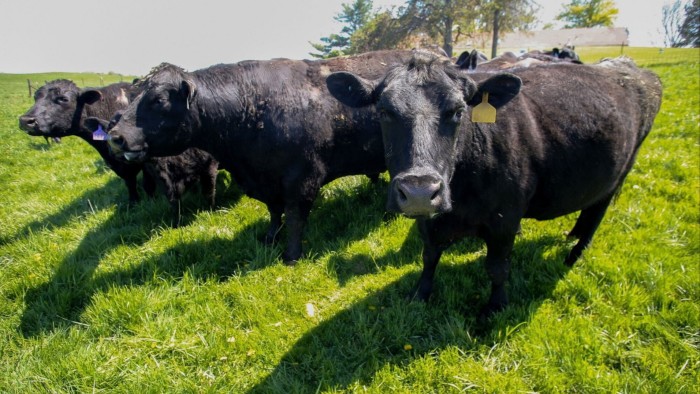Unlock the Editor’s Digest for free
Roula Khalaf, Editor of the FT, selects her favourite stories in this weekly newsletter.
US beef prices are soaring to record highs as the country’s cattle inventory reaches its lowest level in more than 70 years, putting further strains on Americans’ grocery bills.
The average price of a pound of ground beef rose to $5.79 in US cities in March, a 12.8 per cent increase in the past year and the most on record, according to labour department data. The price of uncooked beef steaks also reached record highs at $10.98 per pound.
A years-long drought in the American west has dried up grazing lands and US ranchers have been steadily shrinking their herds, creating a shortage that has raised the price of calves and ultimately other beef products.
Labour and insurance costs have also risen and even though cattle are reaching heavier weights than ever, it is not enough to offset plummeting headcounts.
“Beef is experiencing the most challenging market conditions we’ve ever seen,” Donnie King, the chief executive of Tyson Foods, the largest US meatpacker, told analysts while reporting the company’s second-quarter earnings on Monday.
The result is what Kroger interim chief financier Todd Foley called “outsized inflation” on beef, even as prices on other foods except eggs are expected to remain “steady”. Food prices, and particularly those of eggs, have been a source of frustration for consumers and a focus of the Trump administration.
Persistent inflation was a key theme of Donald Trump’s 2024 presidential campaign, and he has railed against rising food prices. Higher meat costs will weigh on consumer sentiment, particularly as the summer grilling season starts.

Tyson said its customers had begun switching to lower quality cuts or more affordable meats such as chicken as the average price of its beef products rose 8.2 per cent between February and April alone. The shift cost Tyson’s beef business $181mn during the six months that ended in March, though chicken sales carried the meatpacker to profits above analysts’ expectations.
Rising prices may have squeezed meatpackers who now have to pay more for cattle, but they have been a boon to ranchers, who have been squeezed by the rising costs of raising livestock.
“My neighbour, he is going to sell every cow in his place next Tuesday, and it’s not because of drought,” said Carl Ray Polk Jr, president of the Texas & Southwestern Cattle Raisers Association. “It’s not necessarily because of his input cost. It’s because the market is so high.”
“They’re taking advantage just like you would if it was your retirement account or any other investment. When the market is good you may harvest a little bit.”
The trend might delay the years-long process of rebuilding US cattle stocks enough to lower prices at grocery stores and restaurants.

Polk said he is growing his herd by 10 per cent this year by retaining heifers that he would normally sell. He hopes the additional inventory will help him cash in on even higher prices next year.
“I don’t know if I’m doing the right thing,” Polk said. “I’m not an economist, but all indications are that if we maintain a fair weather pattern, market highs are not going away next month, let me just say that.”
The high cattle prices, combined with elevated interest rates, might make it prohibitively expensive for ranchers to replenish their herds if they want to, Polk added. It takes as long as 42 months to raise a steer for beef, meaning that cattle born this month would not be ready for slaughter until the fall of 2028.
David Anderson, a livestock economist at Texas A&M University, said it “hard to see really falling prices.”
“[Repopulation] might be sort of starting to happen, but isn’t really happening really fast yet.”
https://www.ft.com/content/ffd23343-473a-448b-8de7-e509e04a7576


